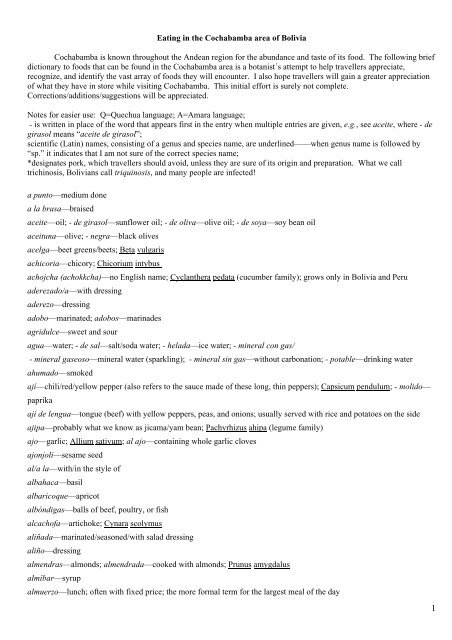Eating in Cochabamba
Eating in Cochabamba
Eating in Cochabamba
Create successful ePaper yourself
Turn your PDF publications into a flip-book with our unique Google optimized e-Paper software.
<strong>Eat<strong>in</strong>g</strong> <strong>in</strong> the <strong>Cochabamba</strong> area of Bolivia<br />
<strong>Cochabamba</strong> is known throughout the Andean region for the abundance and taste of its food. The follow<strong>in</strong>g brief<br />
dictionary to foods that can be found <strong>in</strong> the <strong>Cochabamba</strong> area is a botanist´s attempt to help travellers appreciate,<br />
recognize, and identify the vast array of foods they will encounter. I also hope travellers will ga<strong>in</strong> a greater appreciation<br />
of what they have <strong>in</strong> store while visit<strong>in</strong>g <strong>Cochabamba</strong>. This <strong>in</strong>itial effort is surely not complete.<br />
Corrections/additions/suggestions will be appreciated.<br />
Notes for easier use: Q=Quechua language; A=Amara language;<br />
- is written <strong>in</strong> place of the word that appears first <strong>in</strong> the entry when multiple entries are given, e.g., see aceite, where - de<br />
girasol means “aceite de girasol”;<br />
scientific (Lat<strong>in</strong>) names, consist<strong>in</strong>g of a genus and species name, are underl<strong>in</strong>ed——when genus name is followed by<br />
“sp.” it <strong>in</strong>dicates that I am not sure of the correct species name;<br />
*designates pork, which travellers should avoid, unless they are sure of its orig<strong>in</strong> and preparation. What we call<br />
trich<strong>in</strong>osis, Bolivians call triqu<strong>in</strong>osis, and many people are <strong>in</strong>fected!<br />
a punto—medium done<br />
a la brasa—braised<br />
aceite—oil; - de girasol—sunflower oil; - de oliva—olive oil; - de soya—soy bean oil<br />
aceituna—olive; - negra—black olives<br />
acelga—beet greens/beets; Beta vulgaris<br />
achicoria—chicory; Chicorium <strong>in</strong>tybus<br />
achojcha (achokkcha)—no English name; Cyclanthera pedata (cucumber family); grows only <strong>in</strong> Bolivia and Peru<br />
aderezado/a—with dress<strong>in</strong>g<br />
aderezo—dress<strong>in</strong>g<br />
adobo—mar<strong>in</strong>ated; adobos—mar<strong>in</strong>ades<br />
agridulce—sweet and sour<br />
agua—water; - de sal—salt/soda water; - helada—ice water; - m<strong>in</strong>eral con gas/<br />
- m<strong>in</strong>eral gaseoso—m<strong>in</strong>eral water (sparkl<strong>in</strong>g); - m<strong>in</strong>eral s<strong>in</strong> gas—without carbonation; - potable—dr<strong>in</strong>k<strong>in</strong>g water<br />
ahumado—smoked<br />
ají—chili/red/yellow pepper (also refers to the sauce made of these long, th<strong>in</strong> peppers); Capsicum pendulum; - molido—<br />
paprika<br />
ají de lengua—tongue (beef) with yellow peppers, peas, and onions; usually served with rice and potatoes on the side<br />
ajipa—probably what we know as jicama/yam bean; Pachyrhizus ahipa (legume family)<br />
ajo—garlic; Allium sativum; al ajo—conta<strong>in</strong><strong>in</strong>g whole garlic cloves<br />
ajonjolí—sesame seed<br />
al/a la—with/<strong>in</strong> the style of<br />
albahaca—basil<br />
albaricoque—apricot<br />
albóndigas—balls of beef, poultry, or fish<br />
alcachofa—artichoke; Cynara scolymus<br />
aliñada—mar<strong>in</strong>ated/seasoned/with salad dress<strong>in</strong>g<br />
aliño—dress<strong>in</strong>g<br />
almendras—almonds; almendrada—cooked with almonds; Prunus amygdalus<br />
almíbar—syrup<br />
almuerzo—lunch; often with fixed price; the more formal term for the largest meal of the day<br />
1
amargo—bitter<br />
anacardos—cashews<br />
anchoas—anchovies<br />
andaluza, a la—with red peppers, tomatoes & garlic<br />
añejo—aged<br />
anís—anise/aniseed; Pimp<strong>in</strong>ella anisum<br />
añu—tubers, eaten boiled (other ways?); Tropaeolum tuberosum<br />
aperitivo—appetizer<br />
api(Q)—dr<strong>in</strong>k made from powdered corn & c<strong>in</strong>namon, served warm; color varies accord<strong>in</strong>g to the k<strong>in</strong>d of corn used<br />
apio—celery; Apium graveolens<br />
arándano—cranberry<br />
arrope—a dr<strong>in</strong>k made from the thick layer (called borra) at the bottom of any pot or big jar where chicha has been<br />
prepared with sugar, c<strong>in</strong>namon, and cloves added<br />
arroz—rice; dish or soup with rice as ma<strong>in</strong> <strong>in</strong>gredient; - a la valenciana—rice with chicken or beef and vegetables (see<br />
majado); - caldo—soup with rice;<br />
- blanco—boiled, steamed rice; - con leche—rice pudd<strong>in</strong>g (a breakfast specialty); - con pollo—rice & chicken; -<br />
primavera—rice with vegetables<br />
arvejas—peas; Pisum sativum<br />
asado—roasted<br />
atún—tuna<br />
avellana—hazelnuts<br />
avena—oats/oat meal<br />
aves—poultry<br />
azafrán--saffron<br />
azahar—orange or lemon blossom<br />
azúcar—sugar; brown sugar; - en polvo/glace—powdered/granulated sugar; - morena—brown sugar<br />
banana—small, yellow banana, eaten raw; bananas are not common <strong>in</strong> this area<br />
barbacoa—barbecued; see also porrillada<br />
barra—bar, as <strong>in</strong> bar of candy; - de chocolate—chocolate bar<br />
batido/a—milk shake<br />
bebidas—beverages; - alcohólicas—alcoholic beverages; - gaseosa—carbonated dr<strong>in</strong>ks; - refrescos—soft dr<strong>in</strong>ks<br />
berenjena—eggplant; Solanum melongena<br />
berro—watercress; Rorippa (Nasturtium) offic<strong>in</strong>ale<br />
beterragas—beets; Beta vulgaris<br />
bi-cervec<strong>in</strong>a—dark, non-alcoholic beer<br />
bien cocido; bien pasado—well done<br />
bife/bistec—beef steak<br />
bizcocho—dry cake made from wheat flour, eggs, sugar, grated coconut and any or all of the follow<strong>in</strong>g: vanilla, almonds,<br />
ground peanuts on top—some special k<strong>in</strong>ds are made and sold only dur<strong>in</strong>g Semana Santa (Holy Week=week before<br />
Easter)<br />
blanco—white<br />
2
lando—soft<br />
bodega—w<strong>in</strong>e or sherry cellar<br />
bolitas—balls<br />
bombón—bonbon<br />
boniato—yam<br />
boquerones—white anchovies<br />
borracho/a—with someth<strong>in</strong>g alcholic used <strong>in</strong> the preparation<br />
botella—bottle<br />
brasa—barbecued or grilled<br />
brazo gitano—sponge cake roll with jam fill<strong>in</strong>g<br />
brócoli—broccoli; Brassica oleracea var. botrytis<br />
buñuelo—fried pastry/doughnut<br />
cabello de ángel—angel’s hair pasta; used <strong>in</strong> soups<br />
cabañitas—small fried fish<br />
cabra—goat<br />
cabrito—kid (small goat)<br />
cacao—cocoa (chocolate)<br />
cacerola—casserole<br />
café—coffee; - con azúcar—coffee with sugar; - con leche—coffee with milk; - descafe<strong>in</strong>ado—decaffe<strong>in</strong>ated coffee; -<br />
negro—black coffee<br />
calabacín/ calabacita—zucch<strong>in</strong>i<br />
calabaza—pumpk<strong>in</strong><br />
caldo—hot soup<br />
caliente—hot<br />
camarero/a—waiter/waitress<br />
camarones—shrimp/prawns<br />
camote—sweet potato, may be purple or yellow; Ipomoea batatas<br />
caña—sugar cane stalk that is chewed<br />
canapé—canape<br />
canela—c<strong>in</strong>namon<br />
canelones—cannelloni<br />
caqui—persimmon<br />
caramelo—caramel<br />
cárdamo—cardamom<br />
carne—meat; - asada—roasted meat; - *de cerdo—pork; - de vaca—general term for meat from cows; - molida—canned<br />
pork, used like butter on bread<br />
carnero—mutton or lamb<br />
carta, la—the menu; menú is also used<br />
casa, de la—of the house; home made; may be the specialty of the restaurant<br />
casero/a—homemade; also used as a polite word for “customer”; customer may refer to shopkeeper by this name as well<br />
castañas—chestnuts<br />
3
castellana—bread and garlic soup<br />
cazuela—stew/casserole; - de cordero—lamb stew with vegetables<br />
cebada—barley; Hordeum vulgare<br />
cebolla—onion; Allium cepa<br />
ceboll<strong>in</strong>—scallions<br />
ceboll<strong>in</strong>as—chives<br />
cedrón—a tree with aromatic leaves which are used to brew a medic<strong>in</strong>al tea for stomach aches; Quassia cedron<br />
(Simaroubaceae)<br />
cena—d<strong>in</strong>ner/supper<br />
centeno—rye bread<br />
*cerdo—pork<br />
cereales—cereals<br />
cerezas—cherries<br />
cerveza—beer<br />
cesta de frutas—basket of fruits<br />
chairo—vegetable soup with wheat berries and chuños<br />
charque (Q, A)—sun-dried meat; meat dried with salt; - kan—charque meat cooked briefly directly <strong>in</strong> the fire; - de<br />
llama—from llama<br />
chicha—alcoholic beverage made from corn (maize) and drunk at celebrations large and small; - kulli (Q)—chicha made<br />
from purple maize<br />
*chicharrón—fried pork r<strong>in</strong>ds<br />
chirimoya—custard apple; Annona cherimola<br />
choclo—what we call corn; also, corn on the cob; see maíz<br />
chocolate—chocolate bar<br />
*chorizo—cured pork sausage and/or chicken (nowadays), seasoned with paprika and garlic<br />
chuflay—alcoholic beverage made with s<strong>in</strong>gani, lemon juice, and lemon/lime soda<br />
chuleta—cutlet/chop<br />
chuños/ch’uñu(Q)—small, very dark, dried potatoes; dried by alternately freez<strong>in</strong>g and thaw<strong>in</strong>g and mash<strong>in</strong>g to extract the<br />
water; traditional method for stor<strong>in</strong>g potatoes<br />
churros—fried breakfast pastry<br />
cidra—cider<br />
ciruela—plum<br />
ciruelas pasas/-secas—prunes<br />
clara de huevo—egg white<br />
claro—light <strong>in</strong> color<br />
clavo/clavo de olor—clove<br />
coc<strong>in</strong>a casera—home cook<strong>in</strong>g<br />
*coch<strong>in</strong>ita—chopped pork dish<br />
cocido/a—cooked, boiled, simmered; - al vapor—steamed<br />
coco—coconut<br />
cocoa—chocolate<br />
4
cogollo de palmito—hearts of palm<br />
col de Bruselas—Brussels sprouts<br />
cola—tail<br />
coliflor—cauliflower<br />
comida—meal; family meal (comida literally means food)<br />
completo—complete; used to order a sandwich, hamburger or hot dog with all the topp<strong>in</strong>gs/salads/sauces<br />
con—with; may be abbreviated as “c” on menus<br />
concentrado—concentrate<br />
condimentos—condiments<br />
conejo de castilla—rabbit<br />
conejo kuwi—gu<strong>in</strong>ea pig<br />
confitería—place to get snacks<br />
conserva—used for anyth<strong>in</strong>g canned; preserve<br />
contrafilete de ternera—veal fillet<br />
copa—a dr<strong>in</strong>k<strong>in</strong>g glass<br />
corazón—heart/core<br />
cordero—lamb<br />
corta—made from the first milk that comes after the calf is born mixed with c<strong>in</strong>namon and anise<br />
costilla(s)—chop/spare ribs<br />
costra—crust<br />
crema—cream/mousse/purée; - batida—whipped cream; - española—dessert made from milk, eggs and fruit jelly<br />
crepé—crêpe<br />
criadillas—testicles<br />
croquetas—fish or meat dumpl<strong>in</strong>gs<br />
crudo—raw<br />
cuajada—pot cheese<br />
cubiertos—set of knife, fork, and spoon<br />
cuchara—spoon<br />
cuchillo—knife<br />
cuenta, la—the check/bill<br />
culandro—cilantro/coriander<br />
cuñapés—a biscuit made of cassava flour and melted cheese, eaten fresh or dried<br />
damasco—apricot; Prunus armeniaca<br />
dátil—date; Phoenix dactylifera<br />
delicias—delicious<br />
desayuno—breakfast<br />
descafe<strong>in</strong>ado—decaffe<strong>in</strong>ated<br />
desnatado—low-fat<br />
despojos—offal<br />
día/del—of the day<br />
diente de ajo—clove of garlic<br />
5
donats—doughnuts<br />
dulce—sweet<br />
durazno—peach<br />
emborrachada—mar<strong>in</strong>ated (means “drunk”)<br />
embuchado—stuffed<br />
embutido—fresh sausage<br />
empanada—small dough turnover filled with various <strong>in</strong>gredients, but <strong>in</strong> <strong>Cochabamba</strong>, mostly cheese; may be baked or<br />
fried; see salteña<br />
emparedado—sandwich<br />
encurtido—pickle<br />
endibia/endivia—endive<br />
ensalada—salad/rice salad; - de frutas—fruit salad; - mixta—mixed salad; - verde—green salad<br />
entradas—starters/entrées<br />
escabeche—fish, or any meat (especially pork feet and heads), cooked with onions and peppers with v<strong>in</strong>egar; served cold,<br />
although a similar dish is served hot; especially served on Mondays <strong>in</strong> the afternoon!<br />
escariote—a squash; Cucurbita pepo<br />
escarola—chickory<br />
espaguetis—spaghetti<br />
espalda—back meat<br />
espárrago—asparagus<br />
especialidad—specialty<br />
esp<strong>in</strong>a—small fish bone<br />
esp<strong>in</strong>aca—sp<strong>in</strong>ach<br />
está cubierto—the tip is <strong>in</strong>cluded <strong>in</strong> the charge<br />
estación—<strong>in</strong> season<br />
estilo de—<strong>in</strong> the style of<br />
estofados—stewed (stews)<br />
fabricación casera—homemade<br />
fiambres—cold cuts<br />
fideos—noodles/pasta<br />
filete de lomo—tenderlo<strong>in</strong>; - de res—beef steak; - de ternera—fillet from cow<br />
flan—caramel custard dessert<br />
fresco—fresh/chilled<br />
*fricasé—pork cooked <strong>in</strong> a spicy sauce and served with potatoes and corn<br />
frijoles—beans; Phaseolus vulgaris; - blanco—white beans; - greis—p<strong>in</strong>to beans; - negros—black beans;<br />
- rojos—red (kidney) beans<br />
frío/a—cold<br />
frito—fried (adj.)<br />
frituras—fried th<strong>in</strong>gs (noun)<br />
fruta—fruit<br />
frutilla(s)—strawberries<br />
6
fuerte—extremely spicy; also rich, or strong<br />
galletas—crackers/cookies/biscuits/bread rolls; - con relleno—sandwich cookies<br />
gall<strong>in</strong>a--chicken<br />
gallo—rooster<br />
garbanzos—chickpeas<br />
garapiña—chicha with c<strong>in</strong>namon ice (and perhaps grated coconut) added; sweeter than chicha, so be careful!<br />
gaseosa—carbonated dr<strong>in</strong>k<br />
gelat<strong>in</strong>a—jello<br />
girasol—sunflower<br />
granada—pomegranate; Punica granatum<br />
grande—large<br />
grasa (noun); grasoso (adj.)—fat/fatty<br />
guarnición—garnish/someth<strong>in</strong>g on the side<br />
guayaba—guava; Psidium guava<br />
gu<strong>in</strong>eos—small bananas<br />
guisado—casserole/stew/cooked dish<br />
habas—really big broad beans (a variety of fava beans; Vicia faba) like you´ve never seen <strong>in</strong> the U.S! If served steamed,<br />
remove the coats before eat<strong>in</strong>g.<br />
habichuela—used for all k<strong>in</strong>ds of dried beans<br />
hamburguesa—hamburger<br />
har<strong>in</strong>a—flour: - de maiz—cornmeal<br />
helado—ice cream; - de canela—c<strong>in</strong>namon ice cream (commonly seen!); - de chocolate—chololate ice cream; - de<br />
limón—sweet lemon ice cream; - de va<strong>in</strong>illa—vanilla ice cream<br />
hervido—boiled; poached<br />
hielo—ice<br />
hierba—herb<br />
hígado—liver<br />
higos/higueras—figs/fig trees; Ficus carica<br />
h<strong>in</strong>ajo—dill<br />
h<strong>in</strong>ojo—fennel<br />
hojas—leaves; - de laurel—bay leaves<br />
hongos—mushrooms<br />
horno—oven<br />
horno, al—baked <strong>in</strong> the oven<br />
hortaliza—garden vegetables<br />
hueso—bone<br />
huevos—eggs; - duros—hard-boiled eggs; - pasados por agua—soft-boiled eggs; - revueltos—scrambled eggs<br />
hum<strong>in</strong>ta——ground corn wrapped <strong>in</strong> a corn husk and boiled; slightly sweet; afternoon snack<br />
<strong>in</strong>fusiones—herbal teas<br />
ispi—literally means “fish”; also, t<strong>in</strong>y fish from Lake Titicaca that were the primary source of prote<strong>in</strong> for Incas<br />
jalea—jelly<br />
7
jamachipeke—“arrowroot” of the Andes; perhaps Maranta arund<strong>in</strong>acea<br />
*jamón—cured ham; - cocido—ready to eat ham; - ahumado—smoked ham; - serrano—resembles prosciutto, sliced very<br />
th<strong>in</strong><br />
jard<strong>in</strong>era, a la—served with vegetables<br />
jarra—pitcher<br />
jengibre—g<strong>in</strong>ger<br />
jerez—pale dry sherry<br />
jugo—juice<br />
k´allu/soltero(Q)—salad made of cheese, onion, tomatoes and quilquiña<br />
lacayote—squash; Cucurbita ficifolia<br />
laurel, hojas de—bay leaves<br />
lawa(Q)—thicker than usual soup, such as a cream soup; - de choclo—corn soup; - de chuño—with chuños; - trigo; with<br />
wheat; many other k<strong>in</strong>ds are encountered<br />
leche—milk; - desnatada—skim milk; - entera—whole milk; - en polvo—dried milk<br />
*lechón al horno—roast pork with sweet potatoes<br />
lechuga—lettuce; Lactuca sativa<br />
legumbres--vegetables<br />
lengua—tongue—try it, you´ll like it!<br />
lentejas—lentils; Lens esculenta<br />
levadura—yeast/bak<strong>in</strong>g powder/any leaven<strong>in</strong>g agent<br />
licor—liquor<br />
licuado—milk shake/fruit juices mixed with water<br />
liebre—hare<br />
lima—large, sweet, juicy, refresh<strong>in</strong>g lime as large as an orange<br />
limón—lemon (often looks and tastes like lime—sometimes it is a lime)<br />
limonada—lemonade<br />
lista de platos—menu; - precios—list of prices<br />
llajua—hot pepper sauce (ground locotos, tomatoes, quilquiña, salt)<br />
llauchas—overstuffed cheese empanadas<br />
locoto—fat, round, hot peppers, green, yellow and orange; Capsicum pubescens. You will never be able to exhaust<br />
possibilities for eat<strong>in</strong>g peppers as there are numerous varieties (and degrees of heat!). If you are sensitive, taste carefully<br />
before you take too much of any pepper sauce! These peppers come <strong>in</strong> many shapes, sizes, and colors, so pay attention!<br />
locro—corn and meat soup (from La Paz)<br />
lombarda—red cabbage<br />
*lomo—lo<strong>in</strong>; - montado—tenderlo<strong>in</strong> with two eggs on top; served with rice and lettuce salad with tomatoes and onions<br />
on top<br />
*lomito—tenderlo<strong>in</strong><br />
longaniza—long, spicy sausage<br />
lonja—slice of meat or bread<br />
macarrones—macaroni<br />
maduro—ripe<br />
8
maíz—dried corn<br />
malta—dark, alcoholic beer<br />
malteada—milk shake<br />
mandar<strong>in</strong>a—tanger<strong>in</strong>e; - naranja— mandar<strong>in</strong> orange; relatively new crop <strong>in</strong>troduced <strong>in</strong> an attempt to replace coca<br />
mango/a—mango<br />
maní/maníes—peanut/peanuts<br />
manojo—bunch/handful<br />
mantequilla—butter<br />
manzanas—apples<br />
manzanilla—camomile tea<br />
maracuyá—passion fruit; Passiflora ligularis<br />
margar<strong>in</strong>a—margar<strong>in</strong>e<br />
mariscos—seafood<br />
marraqueta—crusty bread roll<br />
más—more<br />
masa—pastry/dough/pasta<br />
mata-hambre—charque made from rib meat (unless specifically stated to be llama) with hard boiled eggs, potatoes, and<br />
mote de maiz<br />
mate—any dr<strong>in</strong>k made from leaves (herbal teas); - de anís—from anise leaves; - de coca—coca leaf tea (commonly<br />
drunk to prevent altitude sickness); - de manzanilla—chamomile tea; - naranja—from orange leaves; many other<br />
examples—look for them!<br />
mayonesa—mayonnaise<br />
media—half<br />
melón—melon<br />
membrillo—qu<strong>in</strong>ce; Cydonia vulgaris<br />
menta—m<strong>in</strong>t<br />
menú—menu<br />
menudencia(s)—<strong>in</strong>nards that can be eaten; <strong>in</strong>cludes giblets<br />
menudito—chicken and/or beef steak with corn <strong>in</strong> a spicy sauce; snack or meal; a special dish from Sucré<br />
merienda—snack<br />
mermelada—marmalade/jam<br />
mesa—table<br />
mezclado—mixed<br />
miel—honey<br />
migas—bread crumbs<br />
m<strong>in</strong>estrón—vegetable soup<br />
mixto—mixed (or a comb<strong>in</strong>ation)<br />
mondongo—sheep stomach cooked <strong>in</strong> a spicy sauce<br />
mortadela—salami<br />
mostaza—mustard<br />
mote—boiled; -de maiz—from dried corn (like our hom<strong>in</strong>y, but gra<strong>in</strong>s are much larger); - haba—from dried fava beans<br />
9
mozo—waiter<br />
muy bien hecho—meat well done<br />
muy seco—very dry<br />
muzzarella—mozzarella<br />
nabo—turnip; Brassica napus<br />
naranja—orange<br />
nata—the top layer that coagulates on boiled raw milk; used as a spread on bread or fruit or eaten alone<br />
natural—raw or fresh<br />
nectar<strong>in</strong>as—nectar<strong>in</strong>es<br />
negro/a—black<br />
no más—no more<br />
nueces (plural)—walnuts<br />
nuez (s<strong>in</strong>gular)—English walnut; Juglans regia<br />
o—on a menu means “or”<br />
oca/okka(Q)—elongated tuber; Oxalis tuberosa<br />
olla—clay pot; a la olla—stewed <strong>in</strong> a clay pot<br />
omelet—omelette<br />
oporto—port<br />
orégano—oregano<br />
oscuro/a—dark <strong>in</strong> color<br />
pacay—large, dark-colored legume from large tree; white sweet pulp around seeds is eaten; Inga feuillei<br />
pacumutu—beef on a skewer<br />
pajaritos—small birds<br />
palmitos—hearts of palm<br />
paloma—pigeon<br />
palomitas—popcorn; see pipocas<br />
palta—avocado; Persea americana<br />
pan—bread; barra de - —loaf of bread; - de centeno—rye bread; - duro—hard bread; - <strong>in</strong>tegral—whole gra<strong>in</strong> bread; -<br />
rallado—bread crumbs<br />
pancitos—rolls<br />
panecillos—rolls/small loaf of bread<br />
panqueques—pancakes<br />
panza—stomach<br />
papas—potatoes; some 112 varieties <strong>in</strong> Bolivia, <strong>in</strong> many colors and sizes that are seen nowhere else <strong>in</strong> the world; often<br />
<strong>in</strong>cluded <strong>in</strong> dishes with rice or corn; served essentially at any meal except breakfast; - arrugadas—older potatoes (means<br />
“wr<strong>in</strong>kled”) that are preferred for some dishes; - fritas—french fries;<br />
- rellenas—potatoes stuffed with meat or cheese<br />
papa lisa/olluco—no English word, literally “smooth potato”; Ullucus tuberosus; do not confuse with papas; even though<br />
they look like potatoes, the taste is very different; often <strong>in</strong>cluded <strong>in</strong> dishes with rice or corn; very common at meals<br />
except breakfast; not eaten directly upon harvest<strong>in</strong>g but are put <strong>in</strong> the sun for some time before us<strong>in</strong>g<br />
papaya—papaya; Carica papaya<br />
10
papaya japonesa, - de Santa Cruz—resembles a small papaya; Jacaratia hassleriana (papaya family)<br />
parrilla, a la—grilled<br />
parrillada—mixed charcoal grill of meats; can <strong>in</strong>clude any part of the animal<br />
pasado—done/cooked; - poco—rare<br />
pasank’alla—sweet popped corn<br />
pasas—dried fruit/rais<strong>in</strong>s<br />
pastel—pie/cake, but not exactly what we are accustomed to<br />
pastelería—pastry/place to buy pastries<br />
pasteles—pastries<br />
pastelillos/pastelitos (sometimes used as synonyms)—small tarts/cookies/cupcakes<br />
pastilla—candy/piece of hard candy<br />
pata—foot; - de chancho—pig’s feet<br />
patas de cerdo—pig’s feet<br />
patitas de cerdos—pig’s feet<br />
pato—duck<br />
pavita—shredded chicken with mayonnaise <strong>in</strong> a sandwich<br />
pavo—turkey<br />
pechuga—breast of a fowl<br />
pejerrey—k<strong>in</strong>g fish; <strong>in</strong>troduced <strong>in</strong>to Lake Titicaca from Canada<br />
p’ejtu(Q) de habas—a dish with habas and charque of some k<strong>in</strong>d<br />
pepas—seeds<br />
pep<strong>in</strong>illos—pickles made of cucumbers<br />
pep<strong>in</strong>o—cucumber; Cucumis sativus<br />
pepitas—“seeds”—may refer to any k<strong>in</strong>d of seed, e.g., sunflower/pumpk<strong>in</strong> seeds<br />
pequeño—small<br />
pera—pear<br />
perejil—parsley; Petrosel<strong>in</strong>um crispum<br />
perro caliente—hot dog<br />
pescado—fish (dead)<br />
pez—fish (live)<br />
picadillo—ground meat<br />
picado/a—chopped<br />
picante—spicy/hot; - de pollo—spicy dish of boiled chicken served with boiled potatoes and rice<br />
pichón—pigeon<br />
pie(s)—foot/feet<br />
pimentón/pimiento —used for any sweet pepper, regardless of color; Capsicum sp.<br />
pimentón/pimiento morrón—sweet red bell pepper; Capsicum sp.<br />
pimienta—black pepper<br />
see piña—p<strong>in</strong>eapple<br />
piñones—p<strong>in</strong>e nuts<br />
pipocas—popcorn (more commonly used word)<br />
11
pique a lo macho—meat, usually sausage (like Vienna), served with onions, french fries, and other vegetables and eaten<br />
with mayonnaise and/or catsup on top (or mixed <strong>in</strong> to make a slurry); beer used for mix<strong>in</strong>g, if it is the accompany<strong>in</strong>g<br />
beverage<br />
plancha/a la plancha/planchada—grilled<br />
plátanos—edible banana; - de freir—planta<strong>in</strong>s/cook<strong>in</strong>g bananas; fried when no longer green<br />
plato—a dish that one eats/plate that one eats out of<br />
plato Paceño—a dish of mote de habas <strong>in</strong> pods, and papas <strong>in</strong> hot sauce with meat and fried cheese; don’t eat the fava<br />
bean pods or seed coats<br />
plato típico—a dish typical of the area<br />
platos a la carta—special dishes <strong>in</strong> a restaurant (usually more expensive)<br />
platos comb<strong>in</strong>ados—comb<strong>in</strong>ation plates<br />
poco cocido/ - hecho/ - pasado—rare; not recommended! No rare meat is recommended.<br />
pollito—young chicken<br />
pollo—chicken; the ma<strong>in</strong> meat eaten <strong>in</strong> Bolivia because it is less expensive; encountered <strong>in</strong> about every way it is possible<br />
to fix<br />
pomelo—grapefruit<br />
por favor—please<br />
porción—small help<strong>in</strong>g/portion; slice of cake or pastry<br />
porotos—dried beans of any k<strong>in</strong>d, often cooked with onions and a little tomato or sweet pepper<br />
postres—desserts; don´t confuse this with “pastries” although they may be the postre that you prefer<br />
pre-pizza—flat bread such as can be used for mak<strong>in</strong>g pizza<br />
primer plato—starter<br />
prop<strong>in</strong>a—tip; no <strong>in</strong>cluido - —tip not <strong>in</strong>cluded<br />
puchero—dish especially served at Carnival; <strong>in</strong>dividual serv<strong>in</strong>gs layered on the plate as follows: “Irish”<br />
potatoes/cabbage/meat (beef/pork/mutton mixture)/sliced fruit (peach/pear)/overcooked rice that “flows” over the<br />
underneath layers/garbanzos with yellow aji on top<br />
pudín—pudd<strong>in</strong>g<br />
puerco—pork<br />
puerro—leek; Allium porrum<br />
pulpa—slice of beef (leg near hip)<br />
puré de papas—mashed potatoes<br />
queque—cake<br />
quesillo—white, mild cheese made by rural people<br />
queso—cheese; con - —with cheese; - de cabra—goat cheese; - de oveja—mild, salty sheep cheese; - del pais—local<br />
cheese; - paceño—somewhat salty, soft, fresh cheese made from sheep milk<br />
quilquiña—aromatic, pungent native herb; Porophyllum ruderale (daisy family)<br />
qu<strong>in</strong>oa—qu<strong>in</strong>ua; Chenopodium qu<strong>in</strong>oa; one of the “lost gra<strong>in</strong>s of the Incas” that is ga<strong>in</strong><strong>in</strong>g <strong>in</strong> popularity <strong>in</strong> the U.S.<br />
rabanitos—very small radishes; Raphanus sativus<br />
rábano—radish; - picante—horse radish; Armoracia rusticana<br />
rabo—tail<br />
racimo—a bunch (as a bunch of grapes)<br />
12
aciones—large portion; usually said of snacks<br />
raíz—root<br />
rallado—grated<br />
ravioles—ravioli<br />
rebanada—slice<br />
rebozado—coated with breadcrumbs (or flour) and egg, and fried<br />
recargo—extra charge<br />
refrescos—soft dr<strong>in</strong>k/cool dr<strong>in</strong>k<br />
regular—medium well done meat<br />
rehogado—sautéed<br />
rellenos—stuffed/filled; e.g., - de achojcha—stuffed achojcha ; - de locoto—stuffed hot peppers; - de papa—stuffed<br />
potatoes (most common)<br />
remolachas—red beets; Beta vulgaris<br />
repollo—cabbage; Brassica oleracea var. capitata; - para ensalada—red cabbage<br />
repostería de la casa—desserts that are house specialties<br />
requesón—curd cheese but drier than cottage cheese<br />
revueltos—scrambled eggs; - mixto—scrambled eggs with vegetables<br />
riñón—kidney<br />
rodizios—restaurants serv<strong>in</strong>g charcoal steaks along with other meats<br />
rojas--red<br />
rollitos—small filled rolls<br />
rollo de carne—meat loaf<br />
romero—rosemary<br />
rosado—rosé w<strong>in</strong>e<br />
rosbif—roast beef<br />
rosca—doughnut<br />
rosquilla—doughnut, usually glazed<br />
sacar<strong>in</strong>a—sacchar<strong>in</strong><br />
saice—a spicy beef broth served with rice and chuños or papas and tomatoes and onions<br />
sajta de pollo—chicken served <strong>in</strong> ají; - de papa lisa—with papa lisa as a ma<strong>in</strong> <strong>in</strong>gredient<br />
sal—salt<br />
saladitos—salted appetizers<br />
salado—salted<br />
*salchicha—hot dog made from pork sausage<br />
salmuera—<strong>in</strong> br<strong>in</strong>e<br />
salsa—sauce/salad dress<strong>in</strong>g, e.g. - italiana—italian dress<strong>in</strong>g; salad of f<strong>in</strong>ely-diced tomatoes, onions, and locotos<br />
salteado/a—sautéed<br />
salteña—meat (chicken or beef) cooked with any or all of the follow<strong>in</strong>g: onions, peas, potatoes, an olive, rais<strong>in</strong>s, a slice<br />
of egg <strong>in</strong> a spicy sauce, <strong>in</strong>side a baked dough; looks like a puffy empanada; mostly eaten as a snack <strong>in</strong> the mid-morn<strong>in</strong>g,<br />
although they may be for sale throughout the day <strong>in</strong> some places outside <strong>Cochabamba</strong>. Everybody has a favorite place to<br />
eat these!<br />
13
salvado—bran<br />
salvia—sage<br />
sandía—watermelon; Citrulus vulgaris<br />
sandwich—sandwich<br />
sartén, en—from the fry<strong>in</strong>g pan<br />
seco—dry<br />
segundo—ma<strong>in</strong> course<br />
semi-dulce—semi-sweet<br />
semillas—seeds<br />
sencillo—pla<strong>in</strong><br />
servicio—service<br />
servilleta—napk<strong>in</strong><br />
sésamo—sesame<br />
sesos—bra<strong>in</strong>s<br />
setas—mushrooms<br />
silpancho—beef, sliced th<strong>in</strong>, breaded, and fried, placed on sliced, slightly-fried potatoes and rice and served with a fried<br />
egg on top; served with tomatoes, locotos, and onion salad. El Palacio del Silpancho, a restaurant that serves only this<br />
dish, is always crowded.<br />
s<strong>in</strong>gani—alcoholic beverage distilled from grapes<br />
s<strong>in</strong>—without; - gas—without carbonation; - grasa—lean<br />
sofreído—sautéed<br />
sofrito—onions fried with garlic/sautéed<br />
sopa—soup; always served as first course at midday meal; the diversity is so great that it is impossible to taste all of<br />
them; often have whole papas <strong>in</strong> them; - clara—consommé; - de maní—roasted peanut soup served with papas fritas on<br />
top; - de arroz—soup with rice base; - espesa—thick soup<br />
sopita de arroz—soup with a rice base<br />
sorbete—sorbet/cold fruit dr<strong>in</strong>ks<br />
soya—soy<br />
suave—soft<br />
suero—whey<br />
suflé—soufflé<br />
surtido—assorted<br />
surubí—a freshwater fish<br />
suspiros—dry merangues<br />
tajada—slice<br />
tallar<strong>in</strong>es—noodles<br />
tamar<strong>in</strong>do—tamar<strong>in</strong>d; Tamar<strong>in</strong>dus <strong>in</strong>dica<br />
tarhui/tarwi/tauri —lup<strong>in</strong>e seeds; Lup<strong>in</strong>us mutabilis; used to make snack foods resembl<strong>in</strong>g crackers<br />
taza—cup<br />
té—tea; - helado—iced tea<br />
tenedor—fork<br />
14
ternero/a—calf<br />
temperatura ambiente—at room temperature<br />
temporada, de la—of the season; - fruta—fruits <strong>in</strong> season<br />
típico—typical<br />
tisanas—herbal teas<br />
*toc<strong>in</strong>o—bacon<br />
todo <strong>in</strong>cluido—all <strong>in</strong>clusive (price and service)<br />
tojorí—thick porridge of black maíz, milk, and c<strong>in</strong>namon<br />
tomate—tomato<br />
tomillo—thyme<br />
tónica—tonic<br />
toro—bull<br />
toronja—grapefruit<br />
torta—cake/breakfast roll topped with sugar<br />
tortuga—turtle. Neither turtle nor turtle eggs should be eaten by anyone who cares about endangered species.<br />
tostado—toasted<br />
tostado de cereals—dr<strong>in</strong>k made from powdered barley, corn, and wheat, and vanilla<br />
trigo—wheat; Triticum aestivum<br />
triguillo—wheat soup<br />
trimate—tea conta<strong>in</strong><strong>in</strong>g coca, manzanilla and anis; said to be a digestive aid<br />
tripa(s)—tripe<br />
tuétano—bone marrow<br />
tumbo—small passion fruit<br />
tuna—prickly pear fruit; also called cactus pear; Opuntia ficus-<strong>in</strong>dica; - blanca—O. arcei<br />
ulupica—t<strong>in</strong>y, pea-sized pepper that will burn your lips!<br />
utensilio—utensil<br />
uvas—grapes; - pasas—rais<strong>in</strong>s<br />
vaca, carne de—beef<br />
vaca salada—corned beef<br />
va<strong>in</strong>illa—vanilla<br />
va<strong>in</strong>itas—green beans<br />
vapor—steamed<br />
variado—assorted<br />
vaso—glass, large or small<br />
vegetales—vegetables<br />
vegetariano—vegetarian<br />
venado—veal<br />
verde—green<br />
verdolaga—plant used for greens; Portulaca oleracea<br />
verduras—green vegetables<br />
v<strong>in</strong>agre—v<strong>in</strong>egar<br />
15
v<strong>in</strong>agreta—v<strong>in</strong>aigrette<br />
v<strong>in</strong>o—w<strong>in</strong>e; - al t<strong>in</strong>to—baked <strong>in</strong> a red w<strong>in</strong>e sauce<br />
yacón/llacon/aricuma—tubers of Polymnia edulis<br />
yema (del huevo)—yolk of an egg<br />
yerba buena—herb used for flavor<strong>in</strong>g; Satureja douglasii<br />
yerba mate—herbal tea<br />
yogur---yogurt<br />
yuca—cassava; Manihot esculenta<br />
yungeño—dr<strong>in</strong>k made with orange juice and s<strong>in</strong>gani<br />
zanahorias—carrots; Daucus carota<br />
zapallo—pumpk<strong>in</strong>; Cucurbita maxima<br />
zumo—juice<br />
16
















